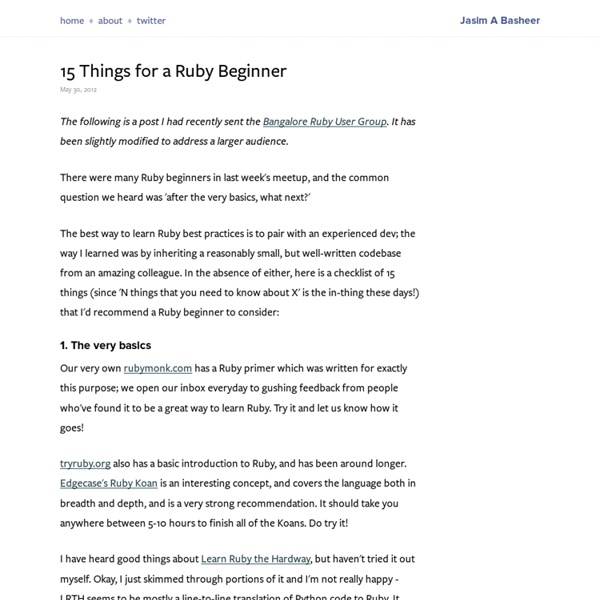CouchDB with CouchRest in 5 minutes
The other night, during our monthly SDRuby meetup, lots of people were very interested in learning more about CouchDB and Ruby. I tried to show what Couch was all about but I didn’t have time to show how to use CouchDB with Ruby. Here is me trying to do that in 10 minutes or less. I’ll assume you don’t have CouchDB installed. Install CouchDB, if you are on MacOSX, you are in luck, download and unzip the standalone package called CouchDBX. That’s it you have couch ready to go, press play and play with the web interface. Next, let’s write a quick script. First, let’s install CouchRest: $ sudo gem install couchrest Now, let’s open a new file and write our script. In line 4 and 5 we are just setting up the server(by default, localhost is being used). SERVER = CouchRest.new DB = SERVER.database! Then, we define your ‘model’, we set the default database to use and define a list of properties. property :last_name, :alias => :family_name Line 14 does something that might seem strange at first.
Beginner's Guide To Ruby On Rails: Part 2
Advertisement Last week we published Getting Started With Ruby On Rails, the first part of our Ruby On Rails introduction. We explained basic ideas behind Ruby and presented concepts and essential components of the language. In this article you’ll learn more about Rails, you will learn how to get Ruby on Rails running on your computer, and get an overview of the basic functionality of Rails and demonstrate how Rails’ main parts work together. I assume you’re already familiar with some other form of Web development, whether PHP, Python, Perl or Java, and relational databases like MySQL. After reading these parts, you should have an idea of whether Rails is for you. You may want to take a look at the following related posts: Get Rolling To get your feet wet with Rails, it’s best to simply install it on your own machine and start playing around. On Windows do the following: Install Ruby 1.8.6 using the one-click installer from www.ruby-lang.org. To edit Ruby code, you can use any text editor.
alexstaubo/sublime_text_alternative_autocompletion
Getting Started With Ruby On Rails
Ruby on Rails Tutorial: Learn Rails by Example book and screencasts by Michael Hartl
Michael Hartl Contents Foreword My former company (CD Baby) was one of the first to loudly switch to Ruby on Rails, and then even more loudly switch back to PHP (Google me to read about the drama). This book by Michael Hartl came so highly recommended that I had to try it, and the Ruby on Rails Tutorial is what I used to switch back to Rails again. Though I’ve worked my way through many Rails books, this is the one that finally made me “get” it. The linear narrative is such a great format. Enjoy! Derek Sivers (sivers.org) Founder, CD Baby Acknowledgments The Ruby on Rails Tutorial owes a lot to my previous Rails book, RailsSpace, and hence to my coauthor Aurelius Prochazka. I’d like to acknowledge a long list of Rubyists who have taught and inspired me over the years: David Heinemeier Hansson, Yehuda Katz, Carl Lerche, Jeremy Kemper, Xavier Noria, Ryan Bates, Geoffrey Grosenbach, Peter Cooper, Matt Aimonetti, Gregg Pollack, Wayne E. About the author Copyright and license 1.1 Introduction
10 Useful Tips For Ruby On Rails Developers
Advertisement By Greg Borenstein and Michael ‘MJFreshyFresh’ Jones Rails is an model-view-controller Web framework written in the Ruby programming language. One of its great appeals is being able to quickly crank out CRUD-based Web applications. Now, we love Rails. In the overview below we present 10 useful tips, ideas and resources for Ruby on Rails-developers (both newbies and professionals). 1. Rails has a well defined plug-in structure that enables you to easily install and use plug-ins in your application. There’s an old nugget of developer wisdom that “the best code is no code at all.” There are a few ways to install a plug-in in Rails, however the most common is using script: # Install from a git repo script/plugin install # Install from a url script/plugin install You can save yourself a ton of time and hassle by becoming good at searching the Web (and especially the almighty GitHub). 2. 3.
Ruby on Windows
Why I Prefer Ruby on Rails over CakePHP by Jimmy Z
Last year, I had a goal to learn Ruby on Rails and build an application in that framework. By learning CakePHP, I was able to wrap my mind around the rails framework concepts and make that transition a little easier. This year, I have made the full plunge into the Ruby on Rails, and I absolutely love it. [note: I still prefer to use CakePHP over no framework if a client requests an application be written in php. Here are some of the reasons why I prefer Ruby on Rails over CakePHP: Rails doesn’t require you to grab all of your data in the controller When working with CakePHP, you must retrieve all of your data from the database in the controller and pass it all to your View. All of the data that you will need from associated models must exist in the array(s) that you pass to your view. Lets say that you have an Author that has many Articles, Articles have many Comments and you would like to grab the Author, her articles, and comments to give to the view. Rails Has Superior Url Routing
Ruby Kickstart



